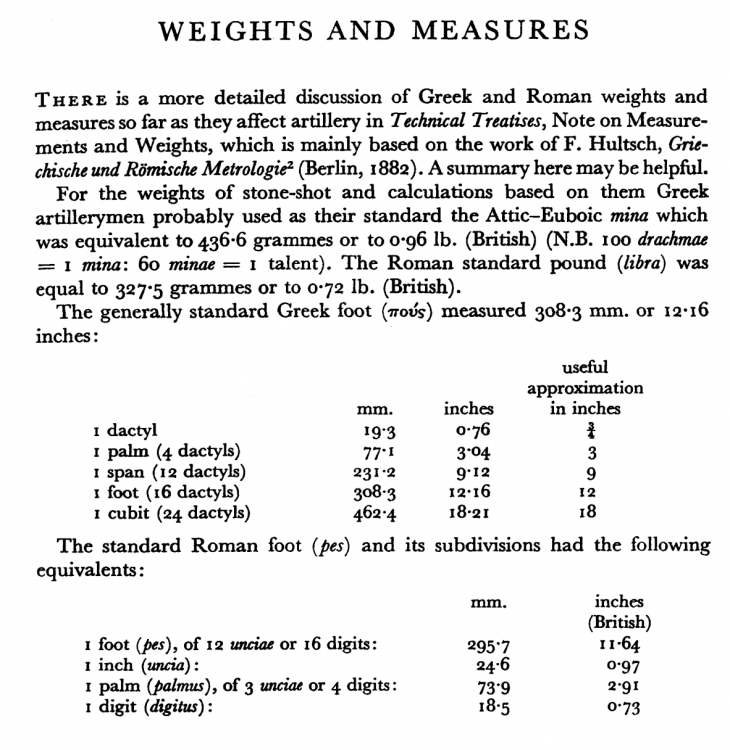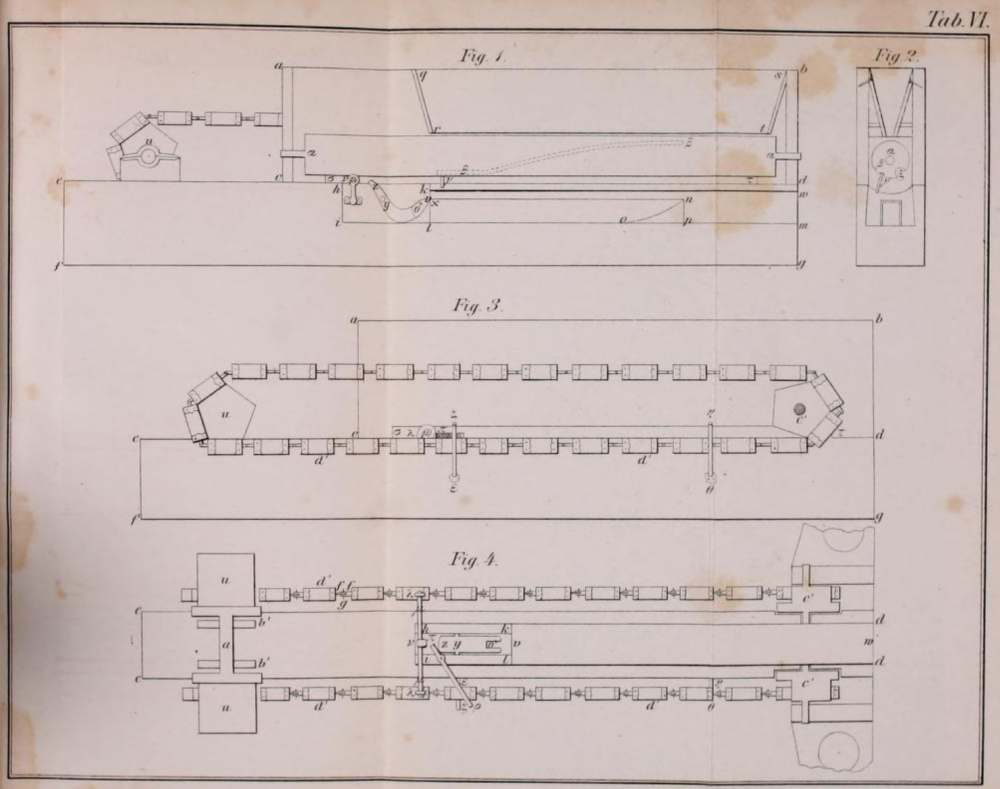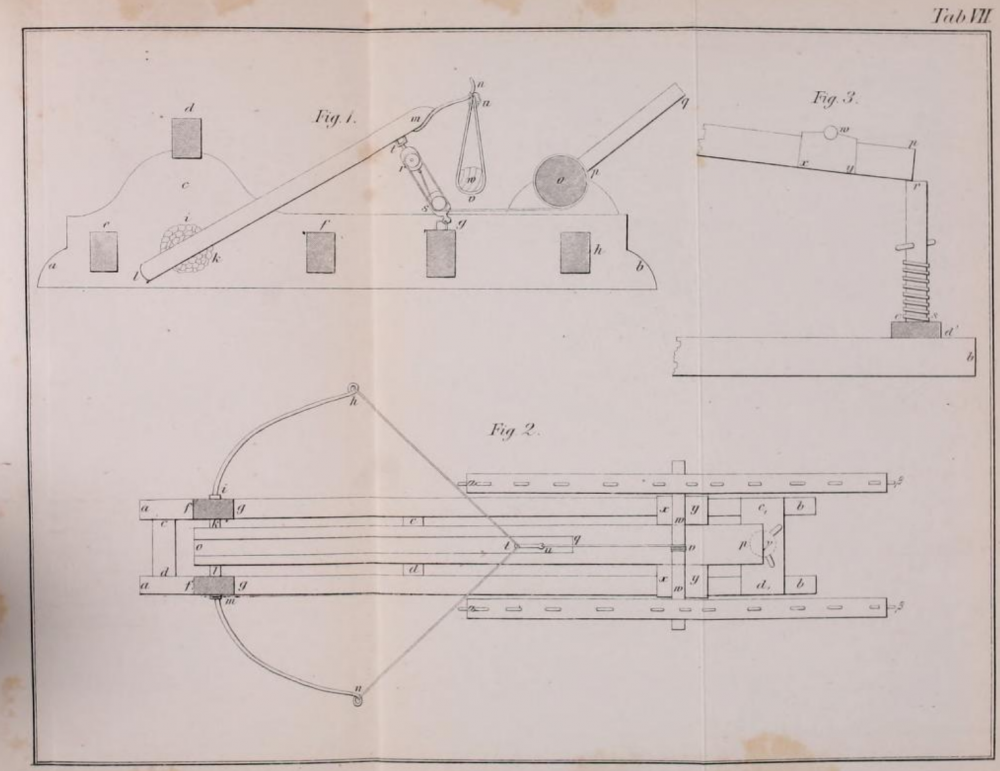-
Posts
2.300 -
Joined
-
Days Won
23
Everything posted by Nescio
-

===[COMMITTED]=== Siege Artillery Rework
Nescio replied to Alexandermb's topic in Completed Art Tasks
One important to keep in mind is that popular references tend to focus on Alexander the Great for the Greeks and for the Romans on Trajan. When you compare a late 4th C BC Greek engine with an early 2nd C AD Roman engine, then yes, you'll undoubtedly see differences, not because one is Greek and the other Roman, but because there is a time difference of about 500 years. 0 A.D. covers the 500-1 BC timeframe. Whenever possible, the point of reference ought to be c. 250 BC. For Carthage and Rome, the focus is on the Punic Wars, especially the Second (218-201 BC). Scipio captured Carthago Nova (in Spain) in 209 BC and with it its arsenal containing hundreds of pieces of artillery, which were shipped to Rome as spoils of war. When Scipio was about to besiege Carthago (in Tunisia) a few years later, he amassed a huge number of bolt-shooters and stone-throwers from three sources: he requested the captured engines from Rome; he ordered the Greek cities in Sicily (Roman vassals) to send him artillery; and he set up a new workshop at Utica (Carthage's sister and neighbour) to produce new ones. Thus the Roman managed to field a high number of artillery, despite the fact that none of those was actually manufactured by the Romans. This is actually typical. BC (our timeframe), Rome did not have an arsenal, unlike many Punic and Greek cities, and Rome relied on allies and vassals to supply artillery. AD (beyond our timeframe), the entire Mediterranean was Roman, there were no longer any non-Roman Greek or Punic cities, and Rome itself had a large arsenal founded by Augustus, and every legion had its own specialists to construct, repair, and operate artillery. Well, I like what you do, my graphical skills are basically non-existent, and I'm not looking for accurate reconstructions; something that seems to give an authentic feel is more than good enough for me. The point I'm making, though, is that, for 0 A.D.'s timeframe, creating same type but different looking artillery for different civilizations is not only a lot of unnecessary extra work, it is also misleading. Creating different calibres is great, but creating different engines of the same calibre ought to be avoided. -
On my end (Fedora 31) it's `.config/0ad/config/user.cfg`; I don't have a `local.cfg` nor a `default.cfg` file there.
-

===[COMMITTED]=== Siege Artillery Rework
Nescio replied to Alexandermb's topic in Completed Art Tasks
Anyway, back to artillery. Let's start with a bit of history: And now let's summarize some key points: Artillery requires skilled people to design, construct, and repair (engineers) and use (artillerymen). Torsion engines were more powerful than non-torsion engines, but also more complex. Artillery had to be kept dry, especially the strings, which were made from horse tails and manes (the most common and cheapest), women's hair (in emergencies), or sinew (the best and most valuable, but also the hardest to produce, therefore reserved for only the most important/prestious/powerful engines). There is a trade-off between range and impact: smaller engines fired lighter projectiles and outranged larger engines, which fired much heavier projeciles. Bolt-shooters operated at angles between 0° (maximum impact) and 30° (maximum range). Stone-throwers operated at angles between 0° (maximum impact) and 45° (maximum range). Bolt-shooter and stone-throwers (at least the smaller ones) could rotate on their bases. Bolt-shooters were far more common than stone-throwers (at most perhaps 1 in 6). For calibres, the numbers refer to the length (bolt-shooters) or weight (stone-throwers) of their projectiles. The most popular were one-cubit (0.46 m), three-span (0.69 m), and two-cubit (0.92 m) bolt-shooters; three-cubit (1.39 m) and larger did exist but were not as common. I guess 0 A.D.'s scorpio is a one-cubit and the oxybeles is two-cubit, so we might want one size in between, the three-span; they should all have a crew of two operators visible, though. For stone-throwers, Vetruvius (X.11.3) lists various calibres, from two-mina (c. 0.9 kg) to six-talent (c. 150 kg). However, these are just theoretical sizes. Based on actual finds, we can conclude the most popular sizes were (E. W. Marsden (1969) 78-83) 20-mina (9 kg), 30-mina (13 kg), 40-mina (18 kg), 60-mina (26 kg) at Pergamon and 25-mina (11 kg), 30-mina (13 kg) at Rhodes. At Carthage, however, 90-mina (39 kg) was also present, but the vast majority were of light calibres (between 10-mina (4 kg) and 20-mina (9 kg)). It's safe to say lighter stone-throwers were most effective for defensive purposes (higher range) and the heavier types for offensive purposes (high impact on shorter range). We already have three different stone-thrower sizes in 0 A.D. I don't think it's necessary to create larger ones. There were no real differences between different arsenals (Carthage, Syracuse, Alexandria, Rhodes, etc.) Engineers travelled around and could find employment abroad; all engines belong to the same tradition. This also means that any engine could be used for multiple civs in 0 A.D. Could you make the projectile thicker? Artillery bolts were much heavier than arrows shot by archers. Again, Carthaginian or Roman engines are no different from Greek ones. -

===[COMMITTED]=== Siege Artillery Rework
Nescio replied to Alexandermb's topic in Completed Art Tasks
Yes, ladders and hooks were by far the most usual siege equipment, and galleries and tunnels to undermine city walls were also quite common. It would be great to have that in 0 A.D. some day. Artillery was available only to the largest city-states and kings, who could maintain arsenals and skilled engineers and artillerymen. -

===[COMMITTED]=== Siege Artillery Rework
Nescio replied to Alexandermb's topic in Completed Art Tasks
Battering rams, tortoises (the protective, slow-moving superstructures protecting men against projectiles), and siege towers are a different subject, but they could be truly enormous, capable of hosting multiple pieces of artillery and numerous troops. According to Vitruvius (X.13.1), the battering was invented by the Carthaginians besieging Gades (Cadiz). Interestingly, he states that the ram was hitting the top of the wall and slowly worked its way down. We know the Assyrians had effective battering ram/tortoise/siege tower machines in the 9th C BC at the latest, centuries before the Carthaginians; they're also depicted as hammering down walls from above (0 A.D.'s Persian ram is evidently based on this): Vitruvius (X.15) describes a very large tortoise constructed by Hegetor of Byzantium; it was about 19 m long and 13 m wide, had a middle flour with artillery, a look-out turret, and a 54 m long battering ram, capable of knocking down 30 m high walls (again implying ramming walls started at the top), operated by a hundred men. Ramming the top of walls rather than the base might seem counter-intuitive (especially when looking at reconstructed medieval rams or most of 0 A.D.'s actors), but it actually makes sense, because walls were strongest at the base and weakest at the top. (@Sundiata, do you happen to know any specifics on siege engines used by the Kushites? Did they also ram walls starting at the top?) Another enormous siege engine described by Vitruvius (X.16.4) is the helepolis built by Demetrius for besieging Rhodes (305 BC), which was reportedly about 40 m high and 20 m wide, and weighted some 150 ton. Of course, ancient authors are more interested in the exceptional and Hegetor's ram and Demetrius' tower were extremes, undoubtedly some of the largest siege engines built in antiquity. Nonetheless, ordinary, much smaller rams and siege towers would still be quite large. City walls 5 m thick and 10 m high with turrets adding another 5 m were not exceptional, and siege towers were supposed to dwarf them, otherwise the besieger would have no advantage over the besieged. -
Before you can start writing templates (which is easy), you first need to decide how many and which phases, resources, and damage types you want to have, next what kind of unit types, and then what structures you'll need for that. Also, is this to be a mod based on some other game or is it to be created from scratch? If you just want pronounceable alien-sounding names, here are a couple three-letter ones: Zaq, Wer, Yui (just typing adjacent keys ).
-

===[COMMITTED]=== Siege Artillery Rework
Nescio replied to Alexandermb's topic in Completed Art Tasks
Another useful drawing on torsion bolt-shooters (left) and stone-throwers (right): And some tables with dimensions of the different parts: Source: E. W. Marsden Greek and Roman Artillery: Historical Development (Oxford 1969). -
Some more drawings on the hand-held gastraphetes, taken from E. W. Marsden Greek and Roman Artillery: Historical Development (Oxford 1969):
-
Sounds great! There are a couple other animals with missing animations, ask @Stan` if you're interested.
-

===[COMMITTED]=== Siege Artillery Rework
Nescio replied to Alexandermb's topic in Completed Art Tasks
But why? As stated earlier, they all followed the same principles and Carthaginian, Greek, Roman engines were fundamentally the same. Wouldn't it be better to just design one good stone-thrower and then scale it to different sizes (e.g. five, let's call them tiny, small, medium, large, huge)? -

===[COMMITTED]=== Siege Artillery Rework
Nescio replied to Alexandermb's topic in Completed Art Tasks
Personally I'd recommend: gastraphetes (handheld): only mace scorpio (small): only rome polybolos (repeating): only ptol oxybeles (normal bolshooter): cart and most greeks -

===[COMMITTED]=== Siege Artillery Rework
Nescio replied to Alexandermb's topic in Completed Art Tasks
Here are ten technical drawings which might help: They're from H. Köchly and W. Rüstow Griechische Kriegsschriftsteller (Leipzig 1853-1855), which is fully scanned: https://archive.org/details/griechischekrieg01kc/page/n5 https://archive.org/details/p1griechischekri02kc/page/n6 https://archive.org/details/griechischekrieg00kcuoft/page/n6 -

===[COMMITTED]=== Siege Artillery Rework
Nescio replied to Alexandermb's topic in Completed Art Tasks
Personally I don't mind having siege engines of different sizes, however, regardless of size, they all follow the same principles and ratios. The ones in those screenshots look way too tall and top-heavy, hence unstable. For stone-throwers the width ought to be 50% of the length and the height 30% of the length (i.e. a 10:5:3 l:w:h ratio). -

===[COMMITTED]=== Siege Artillery Rework
Nescio replied to Alexandermb's topic in Completed Art Tasks
Vitruvius book X is on various machines; scorpions etc are discussed from chapter 10 onwards; see: http://www.perseus.tufts.edu/hopper/text?doc=Vitr.+10&fromdoc=Perseus%3Atext%3A1999.02.0072 http://www.perseus.tufts.edu/hopper/text?doc=Perseus%3Atext%3A1999.02.0073%3Abook%3D10 For what's it worth, Wikipedia has a table of for various calibres: https://en.wikipedia.org/wiki/Torsion_siege_engine#Measurements Also note that while in 0 A.D. there is just one class (“Siege”), historically artillery and siegecraft were separate subjects. -
Locate your `user.cfg` file (see https://trac.wildfiregames.com/wiki/GameDataPaths ) and change the mods entry to: mod.enabledmods = "mod public"
-

Trying to compile game on Mac
Nescio replied to codefisher's topic in Game Development & Technical Discussion
Isn't that a bit too much? It seems 2.0.10 and 3.0.4 respectively are the latest stables. -
Hello and welcome! Also, @Doktoreus and @Itms did some work on updating the design document earlier this year. I don't know if they're still around, though. There is https://trac.wildfiregames.com/wiki/EnglishStyleGuide, although that was written with in-game texts in mind.
-

0 A.D. Development Report: May - August 2019
Nescio replied to Sundiata's topic in Announcements / News
Thanks for the clarification. I believe it to be complete, but please re-read the entire discussion there, try the script, and check for yourself. There is no rush, but I would appreciate it to have eventually, because everytime I upload a diff to phabricator involving a map containing spaces in the file name, Vulcan complains and fails to build, which is quite annoying. -

0 A.D. Development Report: May - August 2019
Nescio replied to Sundiata's topic in Announcements / News
SpiderMonkey follows the same version numbers as Firefox, right, so why specifically 62 and not 70? Biased as I am, I hope map file names will be corrected ( D1042 was proposed over two years ago) eventually. -

0 A.D. Development Report: May - August 2019
Nescio replied to Sundiata's topic in Announcements / News
See https://trac.wildfiregames.com/wiki/BuildInstructions Since 18 May 2018, i.e. over 18 months, and there is still plenty to do ( https://trac.wildfiregames.com/roadmap ), so two years is probably more accurate than one. -
A23? Now there is: SharedLOSautoresearched.zip @Stan`, feel free to upload it to mod.io; I won't. Also, making it a game-setting would be nice, but also more complicated to implement. @nani, off-topic yet somewhat related, it would also be nice if phase advance notifications are communicated to all players, instead of only to allies (and observers) and if each player's current phase would be displayed in the diplomacy window.
-
Personally I think there ought to be third-tier towers for all civilizations, even if they won't all be used, to give maximum flexibility for modders. (Who knows, maybe someone would want to reuse Briton ballista towers in an alternative history or fantasy mod.)
-
Off-topic yet related: https://www.bbc.co.uk/news/world-asia-50531208
-
Actually I don't think it's a good idea to make the width proportional to the health, given the wide range of values (5 to 6000); also blocks will probably look ugly at minimum zoom. My question was whether having different widths for different would make it easier to identify units, as is already the case for ships (fishing boat has a width of 2.0, other ships 6.0). E.g. elephants have a larger footprint and require more population than infantry, so should they have a larger status bar?
























